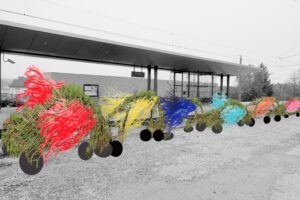
In their installation Kollektives Warten in Extremwetterlage, Markus Hiesleitner and Klara Paterok shed light on the connections between mobility, waiting, and climate change. How long do we want to wait before we act?
At the train station in Steyregg, a series of outlines of passenger cars were positioned in the parking lot along the tracks. The figures were woven from living willow branches that grew during the time of the exhibition and textiles that were moved by the wind and air of the passing train. They brought movement and change to an otherwise static image of a still line of cars that otherwise appeared to have been parked or stuck in traffic for so long that they have been reclaimed by nature.
The installation reminded the viewer that traveling and waiting go hand in hand, but that the passage of time is not irrelevant. While people wait alone in their cars, waiting in trains becomes a collective experience that holds a certain potential. When worsening weather and climate conditions force travelers to abandon their plans and wait, the collective experience can enable group solidarity and empathy, and in moments of distress, the newly formed community adopts a problem-solving attitude. This is valuable ground for the collective mental shift needed to effectively address the climate emergency that lies ahead.
Thanks to: Franz Brunner und flora pondtemporary
Impressions
CV
Markus Hiesleitner setztdeals with the political, social, and economic mechanisms of contemporary society through conceptual and eco-political sculptures and installations.
Markus Hiesleitner-Webside
Klara Paterok observes and analyses urban living spaces. Her interest lies in the development and destruction of patterns and structures, the aesthetics and materiality that form the blueprint for the act of balancing contradictions such as nature and culture, organic and artificial, or functionality and randomness.
Klara Paterok-Webside